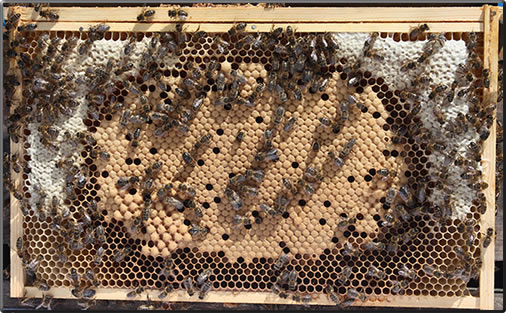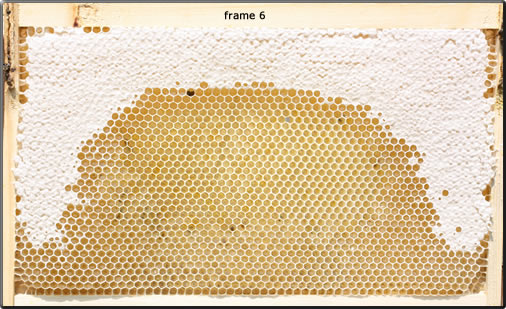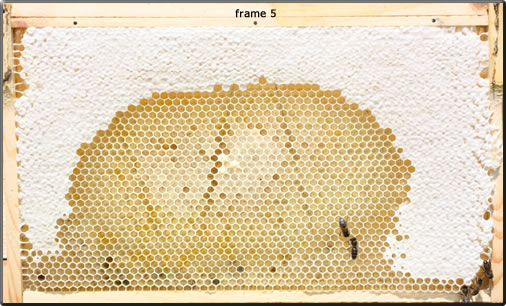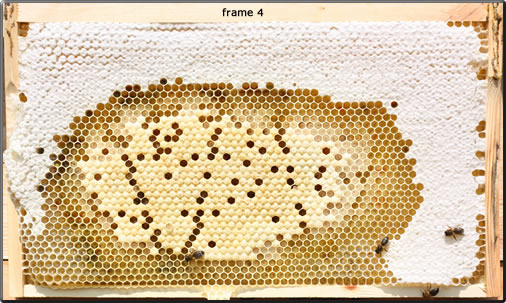
Brood 2
Brood frame patterns
A 'compact brood pattern17' is described as the ideal for the black bee. The brood itself is found to be oval in shape in the centre of the frame, surrounded by an arch of firstly honey and then pollen. This ensures that the food for the grubs in immediately available to the nurse bees. Pollen is sometimes found underneath the brood. The shape of the brood may vary according to the season: early season it may be more spherical but taller in the summer.
The development of the bee from the first laying of the egg to its emergence takes 21 days. The cell number ratio of
egg : grub : sealed brood is then seen to be
3 : 5 : 13.
The queen lays eggs on one side of frame then repeats the pattern on the other side to her satisfaction; this ensures that the metabolic heat emitted by the brood on one side of the frame benefits that on the other side.
The development of the bee from the first laying of the egg to its emergence takes 21 days. The cell number ratio of
egg : grub : sealed brood is then seen to be
3 : 5 : 13.
The queen lays eggs on one side of frame then repeats the pattern on the other side to her satisfaction; this ensures that the metabolic heat emitted by the brood on one side of the frame benefits that on the other side.
This brood frame contains only sealed brood with some drone brood bottom left.



Brood patterns in a new colony
The three frames on the left follow the pattern of brood produced by a new colony with a newly mated queen.
The small colony was given a new brood box with all new frames containing foundation. The first 10 days were spent by the bees drawing out the first frames and storing some honey. The first eggs were seen after 10 days.
The three photos of successive brood frames were taken 26 days after introducing the bees to the box. Frames 1, 2, and 3 (not shown) from the front of the box were full of sealed brood.
Frame 4 shows sealed brood in the middle of the frame surrounded by unsealed grubs. And the white cappings of beautifully sealed honey.
Frame 5 shows the pattern by which the queen lays the eggs i.e. starting at the center of the frames and moving in a circular pattern to the outside.
The grubs at the center are just starting to be sealed (5 days old); 3 sealed cells are seen. These in the middle are surrounded by mature grubs.
Moving away from the center the grubs become smaller until eggs are seen at the periphery.
Frame 6 shows some small grubs in the center of the frame surrounded by eggs.
In all cases the bees firstly build up the frames with stored liquid honey and then remove the honey from the center of each frame when the queen reaches that area in her egg laying capacity.
Frames 7 and 8 (not shown) were being draw out and filled with honey ready for the queen.
Frame 9, 10, and 11 remained unused.
The three frames on the left follow the pattern of brood produced by a new colony with a newly mated queen.
The small colony was given a new brood box with all new frames containing foundation. The first 10 days were spent by the bees drawing out the first frames and storing some honey. The first eggs were seen after 10 days.
The three photos of successive brood frames were taken 26 days after introducing the bees to the box. Frames 1, 2, and 3 (not shown) from the front of the box were full of sealed brood.
Frame 4 shows sealed brood in the middle of the frame surrounded by unsealed grubs. And the white cappings of beautifully sealed honey.
Frame 5 shows the pattern by which the queen lays the eggs i.e. starting at the center of the frames and moving in a circular pattern to the outside.
The grubs at the center are just starting to be sealed (5 days old); 3 sealed cells are seen. These in the middle are surrounded by mature grubs.
Moving away from the center the grubs become smaller until eggs are seen at the periphery.
Frame 6 shows some small grubs in the center of the frame surrounded by eggs.
In all cases the bees firstly build up the frames with stored liquid honey and then remove the honey from the center of each frame when the queen reaches that area in her egg laying capacity.
Frames 7 and 8 (not shown) were being draw out and filled with honey ready for the queen.
Frame 9, 10, and 11 remained unused.